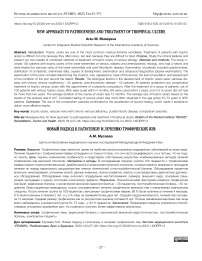New approach to pathogenesis and treatment of trophycal ulcers
Автор: Musayeva Arzu M.
Журнал: Вестник медицинского института "РЕАВИЗ": реабилитация, врач и здоровье @vestnik-reaviz
Рубрика: Морфология. Патология
Статья в выпуске: 1 т.13, 2023 года.
Бесплатный доступ
Introduction. Trophic ulcers are one of the most common medical ailments worldwide. Treatment of patients with trophic ulcers is difficult not only because they often recur, but also because they are difficult to treat. Purpose. Study the clinical features and present our own results of combined methods of treatment of trophic ulcers of venous etiology. Materials and methods. The study involved 100 patients with trophic ulcers of the lower extremities of venous, diabetic and atherosclerotic etiology, who had a history and were treated for varicose veins of the lower extremities and post-thrombotic disease. Examination of patients included questionnaires, clarification of complaints, anamnesis data, causes of development, examination and ultrasound diagnostics (duplex examination). The examination of the ulcer included determining the location, size, appearance, base of the wound, the level of exudation and assessment of the condition of the skin around the defect. Results. The etiological factors in the development of trophic ulcers were: varicose disease with chronic venous insufficiency - 25 patients, post-thrombotic disease - 55 patients. All patients underwent only conservative treatment of trophic venous ulcers with the appointment of a placenta compositum. After the treatment of a group of patients, out of 100 patients with venous trophic ulcers, 89% were cured within 4 months, 8% were cured within 2 years, and in 3 % ulcers did not heal for more than two years. The average duration of the course of ulcers was 12 months. The average size of trophic ulcers based on the results of the analysis was 8 cm2. Complete healing of venous ulcers was most often observed in the age group 61-73 years in 30% patients. Conclusion. The use of the compositum placenta contributed to the acceleration of wound healing, which made it possible to obtain more effective results.
Trophic ulcers, varicose veins with chronic venous deficiency, posttrombotic disease, compositum placenta
Короткий адрес: https://sciup.org/143179928
IDR: 143179928 | DOI: 10.20340/vmi-rvz.2023.1.MORPH.3
Список литературы New approach to pathogenesis and treatment of trophycal ulcers
- Кривощёков Е.П., Яремин Б.И., Атаманов Е.В. Лечение хронической венозной недостаточности в поликлинике. Самара: СамГМУ, 358ОКВГ, 2000. 102 с. [Krivoshchekov E.P., Yaremin B.I., Atamanov E.V. Treatment of chronic venous insufficiency in the clinic. Samara: Samara State Medical University, 358 OKVG, 2000. 102 p. (In Russ)]
- Савельев В.С. Флебология. М., 2001. [Saveliev V.S. Phlebology. Moscow, 2001. (In Russ)]
- Association for the Advancement of Wound Care (AAWC). Summary algorithm for venous ulcer care with annotations of available evidence. Malvern (PA): Association for the Advancement of Wound Care (AAWC); 2005. 25 p.
- Nicolaides A.N. Investigation of chronic venous insufficiency. A consensus statement, 2000.
- Mustoe TA, O'Shaughnessy K, Kloeters O. Chronic wound pathogenesis and current treatment strategies: a unifying hypothesis. Plast Reconstr Surg. 2006;117(7 Suppl):35S-41S. https://doi.org/10.1097/01 .prs.0000225431.63010.1b
- Howard D, Buttery LD, Shakesheff KM, Roberts SJ. Tissue engineering: strategies, stem cells and scaffolds. J Anat. 2008;213(1):66-72. https://doi.org/10.1111/j.1469-7580.2008.00878.x
- Palfreyman S.J., Nelson E.A., Lochiel R., Michaels J.A. Dressings for healing venous leg ulcers. Cochrane Database of Systematic Reviews 2006, Issue 3. Art. No.: CD001103. https://doi.org/10.1002/14651858.CD001103.pub2
- Gohel MS, Barwell JR, Taylor M, Chant T, Foy C, Earnshaw JJ, et al. Long term results of compression therapy alone versus compression plus surgery in chronic venous ulceration (ESCHAR): randomised controlled trial. BMJ. 2007;335 (7610): 83.
- Международный консультативный совет по лечению ран, 2003. [International Advisory Council on Wound Care, 2003. (In Russ)]
- O'Meara S, Al-Kurdi D, Ovington LG. Antibiotics and antiseptics for venous leg ulcers. Cochrane Database of Systematic Reviews 2008, Issue 1. Art. No.: CD003557. https://doi.org/10.1002/14651858.CD003557.
- O'Meara S, Al-Kurdi D, Ologun Y, Ovington LG, Martyn-St James M, Richardson R. Antibiotics and antiseptics for venous leg ulcers. Cochrane Database Syst Rev. 2014 10;(1):CD003557. https://doi.org/10.1002/14651858.CD003557
- Norman G, Dumville JC, Moore ZE, Tanner J, Christie J, Goto S. Antibiotics and antiseptics for pressure ulcers. Cochrane Database Syst Rev. 2016;4(4):CD011586. https://doi.org/10.1002/14651858.CD011586.pub2
- Boateng JS, Matthews M, Stevens H, Eccleston G. Wound healing dressings and drug delivery systems: a review. J Pharmaceutical Sci. 2008; 97(8):2892-2923.
- Govrin J, Kogan L, Luger E. et al. New method for treating hard-to-heal wounds: clinical experience with charged polystyrene microspheres. Wounds UK. 2010; 6(4).
- Berliner et al. A systematic review of pneumatic compression for treatment of chronic venous insufficiency and venous ulcers. 2003. Agency for Healthcare Research and Quality. Р. 1-12.
- Bouza C, Munoz A, Amate JM. Efficacy of modern dressings in the treatment of leg ulcers: A systematic review. Wound Repair and Regeneration. 2005;13:218-229.
- Супильников А.А., Ледовских Е.А., Джамалова Н.М., Трусова Л.А., Старостина А.А., Юнусов Р.Р., Яремин Б.И. Роль митохондрий в патогенезе «сложного» раневого процесса. Вестник медицинского института «РЕАВИЗ». Реабилитация, Врач и Здоровье. 2022;(5):28-36. https://doi.org/10.20340/vmi-rvz.2022.5.CLIN.2 [Supilnikov A.A., Ledovskikh E.A., Dzhamalova N.M., Trusova L.A., Starostina A.A., Yunusov R.R., Yaremin B.I. The role of mitochondria in the pathogenesis of the "complex" wound process. Bulletin of the Medical Institute "REAVIZ" (REHABILITATION, DOCTOR AND HEALTH). 2022;(5):28-36. (In Russ). https://doi.org/10.20340/vmi-rvz.2022.5.CLIN.2]


